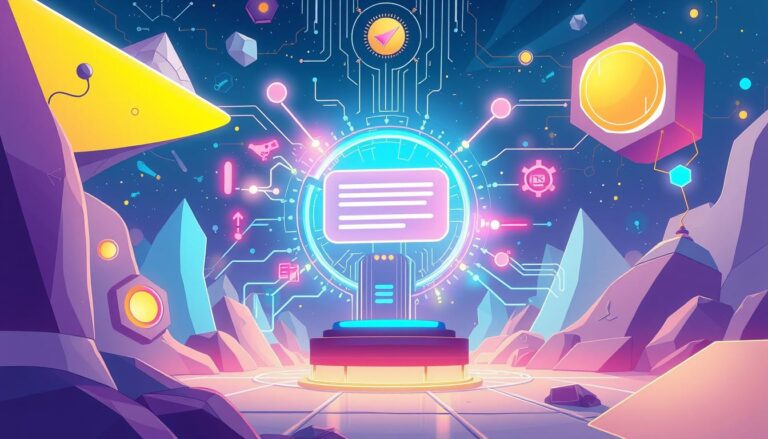Utilizing Chatbots for Improved Customer Service and Engagement
Implementing chatbots in customer service enhances response times, personalizes interactions, and drives satisfaction. These bots offer 24/7 support, quick feedback, and tailored solutions, boosting loyalty and operational efficiency. Automated responses streamline operations and align with brand tone, anticipating issues proactively. Despite challenges like training and feedback incorporation, chatbots enhance customer service delivery. Monitoring effectiveness through KPIs and feedback guarantees peak performance. Future trends hint at even more advanced capabilities and user experience enhancements. Embracing chatbots is a strategic move for businesses seeking to thrive in the digital era.
Key Takeaways
- Customized chatbots for tailored interactions and personalized solutions.
- 24/7 support with quick responses and consistent service quality.
- Proactive communication for customer engagement and satisfaction.
- Data-driven insights for understanding behavior and preferences.
- Automated responses to enhance operational efficiency and brand alignment.
Benefits of Chatbots in Customer Service
Leveraging chatbots in customer service operations enhances efficiency, boosts customer satisfaction, and streamlines communication processes. Chatbot customization allows businesses to tailor interactions to meet specific customer needs, providing personalized solutions that drive engagement. By analyzing customer interactions, chatbots generate valuable customer insights that can inform strategic decision-making and enhance overall service delivery.
Real-time feedback mechanisms integrated into chatbots enable businesses to gather immediate responses from customers, allowing for quick adjustments and improvements based on real-time data. This immediate feedback loop not only enhances user experience but also helps in resolving issues promptly, leading to higher customer satisfaction levels.
Additionally, chatbots provide a seamless user experience by offering 24/7 support, quick response times, and consistent service quality. This level of service reliability contributes significantly to building trust and loyalty with customers, ultimately fostering long-term relationships.
Enhancing Customer Engagement With Chatbots
To further optimize customer interactions and drive deeper engagement, businesses can harness the capabilities of chatbots as powerful tools for enhancing customer engagement. Chatbots offer a unique opportunity to improve engagement by providing instant responses to customer inquiries, personalized recommendations based on customer preferences, and proactive communication to keep customers informed and engaged.
By incorporating chatbots into customer service strategies, businesses can create seamless and interactive experiences that enhance customer satisfaction and loyalty.
Data-driven insights from chatbot interactions can also help businesses understand customer behavior, preferences, and pain points, enabling them to tailor their products and services to better meet customer needs. Through continuous analysis of chatbot interactions, businesses can identify trends, gather feedback, and make informed decisions to further improve engagement and overall customer satisfaction.
Implementing Chatbots for 24/7 Support
With the increasing demand for round-the-clock support services, businesses are strategically implementing chatbots to provide 24/7 customer assistance. AI integration plays an important role in enabling chatbots to deliver seamless support at any hour of the day. By incorporating artificial intelligence into chatbot systems, businesses can guarantee that customers receive instant responses to their inquiries, even outside of regular business hours. This not only enhances customer satisfaction but also increases operational efficiency by reducing the need for human intervention during non-peak times.
Moreover, chatbots equipped with AI integration can provide real-time solutions to customer issues, further improving the overall support experience. Whether it's answering frequently asked questions, troubleshooting technical problems, or guiding users through a purchase process, chatbots can deliver timely and accurate assistance without delay. This capability not only enhances customer service but also helps businesses streamline their support operations to meet the growing demand for instant, round-the-clock assistance.
Personalizing Customer Interactions Through Chatbots
Incorporating personalized customer interactions through chatbots enhances user engagement and fosters a tailored approach to addressing individual needs efficiently. Personalization strategies are vital in creating meaningful interactions with customers. Chatbots can be programmed to use customer data such as past purchases, preferences, and browsing history to tailor responses and recommendations. By leveraging this data, businesses can offer personalized product suggestions, promotions, and support, increasing the likelihood of conversion and customer satisfaction.
Engagement tactics play a significant role in enhancing the customer experience. Chatbots can be designed to initiate conversations based on specific triggers, keeping users actively engaged. Additionally, interactive elements such as quizzes, polls, or product recommendations can be integrated into the chatbot interface to make interactions more dynamic and enjoyable for customers.
Increasing Efficiency With Automated Chat Responses
Utilizing automated chat responses can greatly enhance operational efficiency and streamline customer interactions in a data-centric customer service environment. Chatbot customization options play a pivotal role in fine-tuning automated responses to align with the brand's tone and meet customer expectations effectively. By tailoring responses based on specific customer queries or issues, businesses can guarantee a personalized experience that resonates with their audience.
Training chatbot algorithms is another critical aspect of maximizing efficiency in automated chat responses. Through continuous learning and refinement, chatbots can become more adept at understanding customer inquiries and providing accurate and relevant solutions promptly. By analyzing past interactions and customer feedback, organizations can optimize chatbot algorithms to anticipate common issues and deliver proactive responses, further enhancing operational efficiency.
Overcoming Challenges in Chatbot Implementation
Handling the complexities of chatbot implementation can present unique challenges to organizations. This includes addressing implementation hurdles and overcoming the chatbot learning curve. These obstacles require a strategic approach that leverages data-driven insights to secure a successful integration of chatbot technology.
Implementation Hurdles Addressed
Addressing the complexities of chatbot implementation involves a strategic approach that prioritizes overcoming key challenges to guarantee successful deployment and functionality.
Chatbot training is vital to make sure the bot understands the context of interactions and can provide accurate responses. Implementing a robust training program that includes a diverse range of conversation scenarios can enhance the chatbot's effectiveness.
Additionally, incorporating mechanisms for collecting and analyzing customer feedback is essential. Customer feedback helps in identifying areas where the chatbot may be lacking and allows for continuous improvement.
Chatbot Learning Curve
To successfully navigate the chatbot learning curve in implementation, it is crucial to develop a thorough training strategy that encompasses a varied array of conversation scenarios to enhance the bot's adaptive capabilities. Improving user experience hinges on the chatbot's ability to comprehend and respond effectively to diverse user queries.
Chatbot training techniques should include machine learning algorithms, natural language processing, and continuous feedback mechanisms to refine the bot's responses over time. By exposing the chatbot to a wide range of interactions during its training phase, organizations can equip it to handle complex user inquiries and provide accurate, personalized responses.
This strategic approach ensures that the chatbot evolves into a valuable asset for enhancing customer service and engagement.
Measuring Success: KPIs for Chatbot Performance
When evaluating the effectiveness of chatbots in customer service, it is essential to establish key performance indicators (KPIs) to measure their performance accurately. Chatbot analytics play an important role in evaluating how well the chatbot is serving customers. Metrics such as response time, resolution rate, and user satisfaction ratings provide valuable insights into the chatbot's effectiveness. Additionally, monitoring user experience through feedback and sentiment analysis helps in understanding customer interactions and areas for improvement.
Chatbot training is another critical aspect in ensuring peak performance. Measuring impact through KPIs like accuracy rates, escalation frequency, and conversational depth can gauge the effectiveness of training efforts. By analyzing these KPIs, organizations can identify training needs and refine chatbot capabilities to enhance customer service delivery.
Future Trends in Chatbot Technology
As organizations continue to harness the power of chatbots for customer service excellence, exploring the evolving landscape of future trends in chatbot technology becomes imperative for staying ahead in the competitive market.
The future of chatbot technology is poised for significant advancements, driven by the following key trends:
- Chatbot Evolution: Chatbots are evolving beyond basic question-and-answer interactions. Future chatbots will have enhanced capabilities, integrating advanced natural language processing and machine learning algorithms to provide more personalized and context-aware responses.
- AI Advancements: Artificial Intelligence (AI) will continue to play an important role in shaping the future of chatbots. AI advancements will enable chatbots to better understand user intent, emotions, and preferences, leading to more intelligent and human-like conversations.
- User Experience: The focus will shift towards enhancing user experience through conversational interfaces. Future chatbots will prioritize seamless interactions, proactive engagement, and intuitive design to create a more satisfying user experience.
These trends underscore the importance of staying informed and adapting to the dynamic landscape of chatbot technology to meet the evolving demands of customers.
Conclusion
To sum up, the utilization of chatbots in customer service has shown significant benefits and potential for enhancing engagement and efficiency. According to a recent study by IBM, businesses that have implemented chatbots have reported a 40% increase in customer satisfaction rates.
As technology continues to advance, the future trends in chatbot technology will likely revolutionize customer service even further, making it an essential tool for businesses looking to improve their customer interactions.







